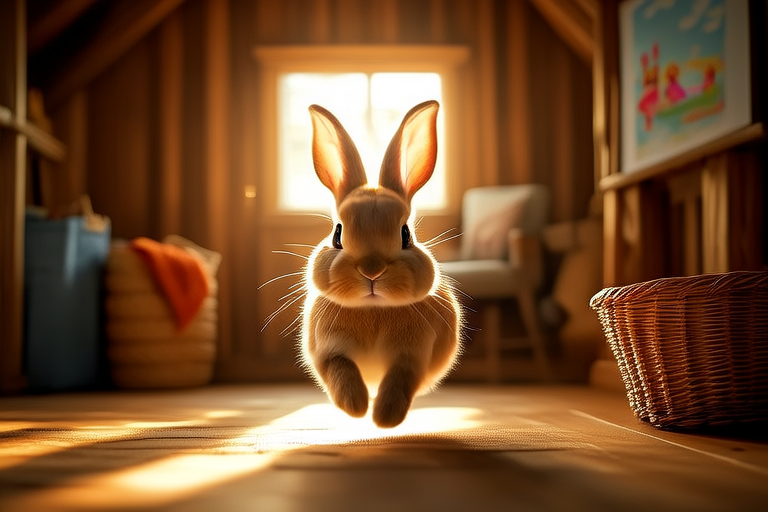From Barnyard to Living Room: A Journey with Lop Rabbits as Pets
Lop rabbits, known for their distinctive floppy ears, have journeyed from humble beginnings in barnyards to becoming cherished pets in modern homes. Their transformation is a testament to their endearing nature and adaptability, making them a popular choice among animal enthusiasts. This article explores the history, breeds, care, and companionship offered by lop rabbits, offering valuable insights for prospective owners.
The Origins and Evolution of Lop Rabbits
Historically, lop rabbits were primarily bred for meat and fur, thriving in the rural settings of barnyards and farms. Over time, selective breeding focused on enhancing their docile temperament and unique appearance, eventually leading to the domestication of lop rabbits. Today, they are beloved for their gentle demeanor and suitability as family pets. The transition from farm animals to household companions reflects the changing relationship between humans and animals, where companionship and emotional bonds are increasingly valued.
Varieties of Lop Rabbit Breeds
Several lop rabbit breeds exist, each distinguished by its physical attributes and temperament:
- English Lops: These are the largest lop breeds, known for their impressive size and floppy ears that can reach up to 24 inches. They are gentle giants, ideal for families seeking a large, affectionate companion.
- French Lops: Slightly smaller than English Lops, French Lops are robust and muscular, with shorter ears. They are known for their friendly and calm disposition, making them excellent pets for both adults and children.
- Dutch Lops: The smallest lop breed recognized by the American Rabbit Breeders Association (ARBA), Dutch Lops are compact and energetic. Their alertness and playfulness make them delightful companions.
- Belgian Hares: Though not true lops, these rabbits are often included due to their close resemblance. They are lively and active, requiring more space and stimulation compared to other lop breeds.
Physical Characteristics and Temperament
Lop rabbits possess several defining features. Their most notable characteristic is their long, floppy ears, which can vary in length depending on the breed. Their coats come in a variety of colors and patterns, adding to their charm. Their eyes are typically large and expressive, giving them an endearing appearance. Lop rabbits are generally calm and docile, making them ideal for family life. They are intelligent and can form strong bonds with their human caregivers, often responding well to positive reinforcement training.
Housing Your Lop Rabbit
Providing appropriate housing is crucial for your lop rabbit’s well-being. Indoor living is recommended for lop rabbits, especially in areas with extreme weather conditions. A spacious cage or enclosure with ample room for movement and exercise is essential. The cage should be lined with soft bedding material like hay or straw to ensure comfort. Regular cleaning of the living area is necessary to maintain hygiene and prevent the buildup of bacteria.
Feeding Your Lop Rabbit
A balanced diet is vital for the health of your lop rabbit. Their primary food source should be high-quality hay, which aids in digestion and dental health. Fresh vegetables, fruits, and pellets formulated specifically for rabbits should also be provided in moderation. It is important to avoid foods that are harmful to rabbits, such as chocolate, caffeine, and certain types of nuts. Always provide fresh water daily, ensuring it is clean and accessible.
Grooming and Enrichment
Grooming is an essential aspect of caring for your lop rabbit. Regular brushing helps to remove loose fur and prevent matting, particularly during shedding seasons. Bathing should be minimal and only when necessary, as frequent bathing can strip the rabbit’s coat of natural oils. Providing toys and tunnels encourages mental and physical stimulation, preventing boredom and promoting healthy behavior.
Common Health Issues and Prevention
Lop rabbits, like all animals, are susceptible to certain health issues. Dental problems are common, often resulting from poor diet or genetics. Ensuring a proper diet rich in hay and regular veterinary check-ups can help prevent these issues. Respiratory infections can also occur, particularly in environments with poor ventilation. Maintaining a clean and well-ventilated living space is crucial for respiratory health. Parasites such as mites and fleas can infest rabbits, necessitating regular inspection and treatment if necessary. Vaccinations against common diseases should be administered as recommended by a veterinarian.
Bonding and Training Basics
Bonding with your lop rabbit involves spending quality time together, allowing them to become comfortable with your presence. Gentle handling and consistent interaction are key. Training can include basic commands like coming when called or sitting on command. Positive reinforcement techniques, such as offering treats and praise, are effective in teaching your rabbit new behaviors. Socialization with other rabbits can also enhance their social skills and reduce stress.
Conclusion: A Rewarding Experience
Welcomeing a lop rabbit into your home is a rewarding experience filled with love and companionship. However, it comes with significant responsibilities. Proper care, attention, and commitment are essential to ensure the well-being of your pet. By understanding the needs and characteristics of lop rabbits, you can provide them with a happy and healthy life. Embrace the joy of sharing your home with these charming creatures and enjoy the enriching bond that forms between you and your lop rabbit.
